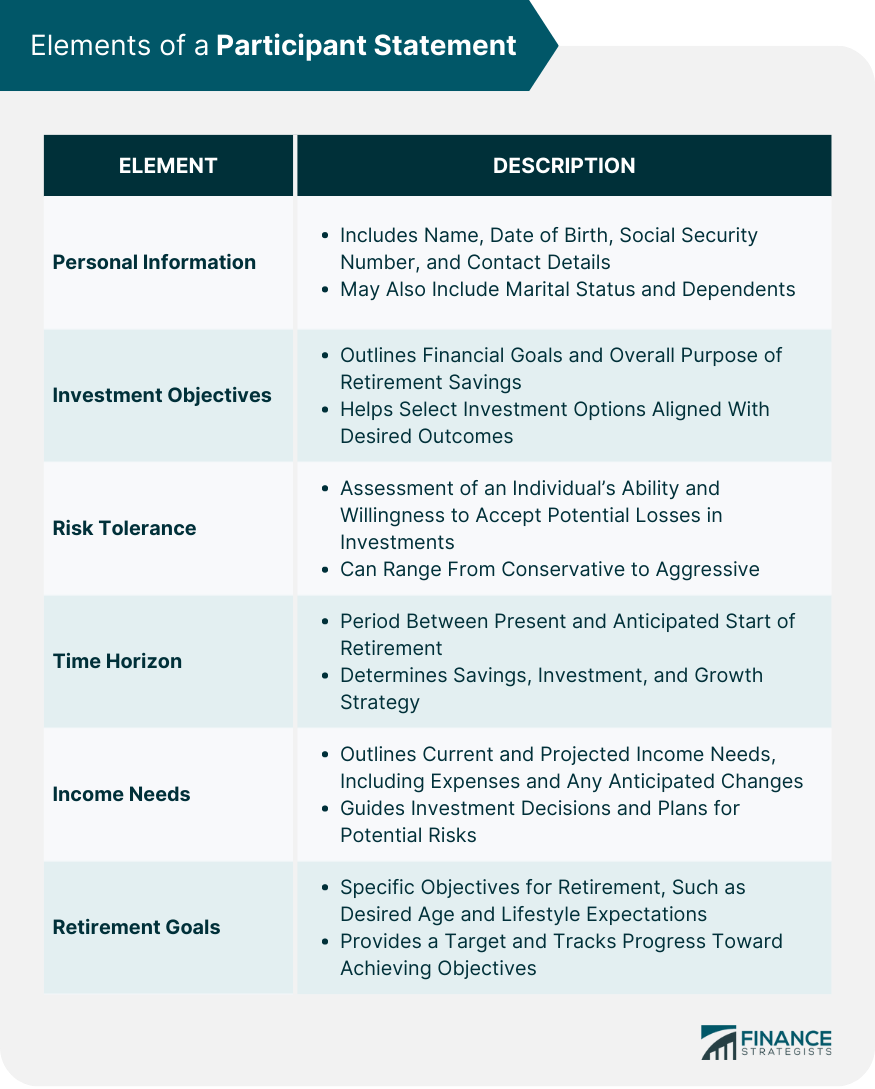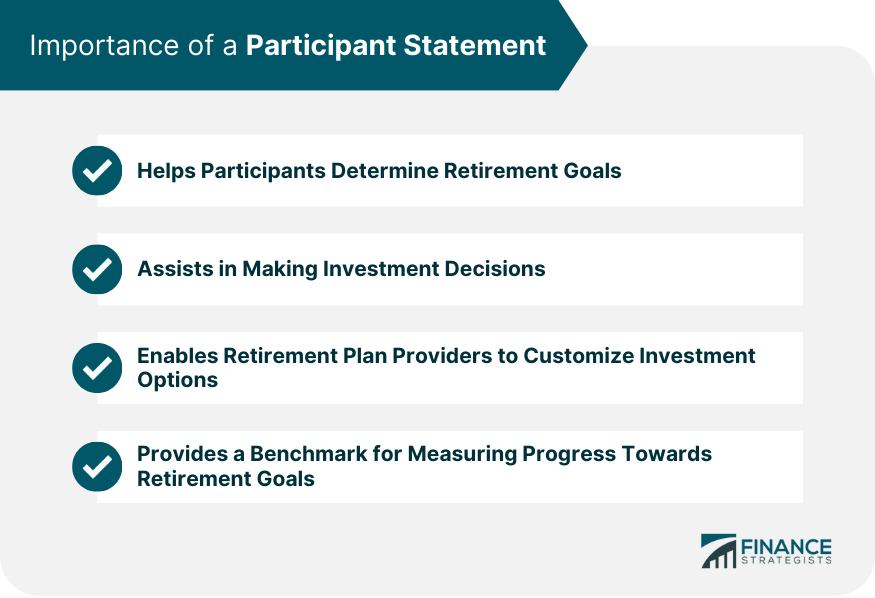A participant statement in retirement planning is a document that outlines an individual's financial information, investment objectives, risk tolerance, and retirement goals. This statement serves as a foundation for retirement planning and guides the participant, as well as financial advisors and plan providers, in making investment decisions that align with the participant's unique needs and objectives. A comprehensive participant statement is crucial for effective retirement planning. It allows individuals to understand their current financial situation and set realistic retirement goals. This also helps financial advisors and plan providers to customize investment options based on the participant's specific needs and risk tolerance. In essence, a well-prepared participant statement is the cornerstone of a successful retirement planning strategy. The participant statement begins with the individual's personal information, such as their name, date of birth, Social Security number, and contact details. This information is essential for accurately identifying the participant and ensuring that any communications, account statements, and tax documents are correctly directed to the appropriate individual. In addition, the personal information section may include details about the participant's marital status and dependents, as these factors can significantly impact retirement planning decisions. The investment objectives section of a participant statement outlines the participant's financial goals and the overall purpose of their retirement savings. This may include objectives such as capital preservation, income generation, or long-term growth. Clearly defining these objectives helps the participant and their financial advisor to select investment options that are aligned with the desired outcomes. Moreover, understanding one's investment objectives can help participants stay focused on their goals and avoid making impulsive decisions that may jeopardize their long-term financial security. Risk tolerance refers to an individual's ability and willingness to accept potential losses in their investments in pursuit of higher returns. The participant statement should include an assessment of the participant's risk tolerance, which can range from conservative to aggressive. Knowing one's risk tolerance is crucial for selecting appropriate investment options and maintaining a well-diversified portfolio that balances potential risks and rewards. The time horizon is the period between the present and the anticipated start of retirement. This factor is critical in retirement planning, as it determines the amount of time an individual has to save, invest, and grow their retirement assets. The participant statement should include the participant's current age and expected retirement age, allowing for an accurate estimation of their time horizon. A longer time horizon typically allows for a more aggressive investment strategy, while a shorter time horizon may require a more conservative approach to minimize potential losses. The participant statement should outline the individual's current and projected income needs, including sources of income, expenses, and any anticipated changes in these factors. This information helps participants determine the amount of retirement savings needed to maintain their desired standard of living and can guide investment decisions accordingly. Additionally, understanding one's income needs can assist in planning for potential risks, such as inflation or unexpected expenses, that may arise during retirement. The retirement goals section of a participant statement includes specific objectives for the individual's retirement, such as desired retirement age, lifestyle expectations, and any planned major expenditures, such as travel or healthcare costs. These goals provide a clear target for the participant's retirement planning efforts and enable them to track their progress toward achieving these objectives. Having well-defined retirement goals is essential for maintaining motivation and staying on track with one's retirement planning strategy. A comprehensive participant statement assists individuals in defining their retirement goals by providing a clear picture of their current financial situation, investment objectives, and risk tolerance. This information allows participants to set realistic expectations and develop a retirement plan that aligns with their unique needs and aspirations. By establishing clear retirement goals, participants can better understand the steps they need to take to achieve these objectives and make more informed decisions about their retirement savings strategy. A participant statement serves as a valuable guide for making investment decisions, as it outlines the individual's investment objectives, risk tolerance, and time horizon. This information enables participants and their financial advisors to select investment options that are consistent with their goals and risk preferences. Additionally, having a well-prepared participant statement can help individuals maintain focus on their long-term objectives, avoid emotional decision-making, and make necessary adjustments to their investment strategy as their circumstances change. A participant statement is not only beneficial for individuals but also for retirement plan providers. By understanding the unique needs and objectives of their participants, plan providers can offer customized investment options and services that better align with the participant's financial goals. This personalized approach can lead to more effective retirement planning and ultimately result in better outcomes for participants. A participant statement also serves as a benchmark for monitoring progress towards retirement goals. By regularly reviewing and updating their participant statement, individuals can track their financial growth, assess whether they are on track to achieve their objectives, and make necessary adjustments to their retirement planning strategy as needed. Having a clear benchmark helps participants maintain motivation and stay accountable to their retirement goals, ensuring that they remain focused on their long-term financial security. A participant statement is a vital component of effective retirement planning. It provides individuals with a comprehensive overview of their financial situation, investment objectives, risk tolerance, and retirement goals, enabling them to make informed decisions about their retirement savings strategy. Additionally, a well-prepared participant statement can assist financial advisors and plan providers in offering customized investment options that align with the participant's unique needs and objectives. To ensure a successful retirement planning strategy, it is recommended that participants take the time to complete a comprehensive participant statement. This process involves gathering accurate personal and financial information, assessing investment objectives and risk tolerance, estimating income needs and expenses, and setting clear retirement goals. Regularly reviewing and updating the participant statement is also crucial, as it allows participants to track their progress towards their retirement objectives and make any necessary adjustments to their investment strategy as their circumstances change. By taking these steps, individuals can create a solid foundation for their retirement planning efforts and increase the likelihood of achieving their desired financial security in retirement.What Is a Participant Statement?
Elements of a Participant Statement
Personal Information
Investment Objectives
Risk Tolerance
Time Horizon
Income Needs
Retirement Goals

Importance of a Participant Statement
Helps Participants Determine Retirement Goals
Assists in Making Investment Decisions
Enables Retirement Plan Providers to Customize Investment Options
Provides a Benchmark for Measuring Progress Towards Retirement Goals

Conclusion
Participant Statement FAQs
A participant statement is a document that outlines an individual's personal information, investment objectives, risk tolerance, time horizon, income needs, and retirement goals.
A participant statement helps participants determine their retirement goals, make investment decisions, and provides a benchmark for measuring progress towards their retirement goals.
Anyone who participates in a retirement plan, such as a 401(k), should complete a participant statement to ensure that their investment objectives align with their retirement goals.
A comprehensive participant statement typically includes personal and contact information, investment objectives and risk tolerance, time horizon and retirement goals, income and expense information, and current investment holdings.
Yes, a participant statement can be updated or changed as personal circumstances change or investment objectives shift. It's important to regularly review and update the participant statement to ensure it remains aligned with retirement goals.
True Tamplin is a published author, public speaker, CEO of UpDigital, and founder of Finance Strategists.
True is a Certified Educator in Personal Finance (CEPF®), author of The Handy Financial Ratios Guide, a member of the Society for Advancing Business Editing and Writing, contributes to his financial education site, Finance Strategists, and has spoken to various financial communities such as the CFA Institute, as well as university students like his Alma mater, Biola University, where he received a bachelor of science in business and data analytics.
To learn more about True, visit his personal website or view his author profiles on Amazon, Nasdaq and Forbes.















